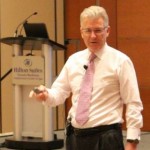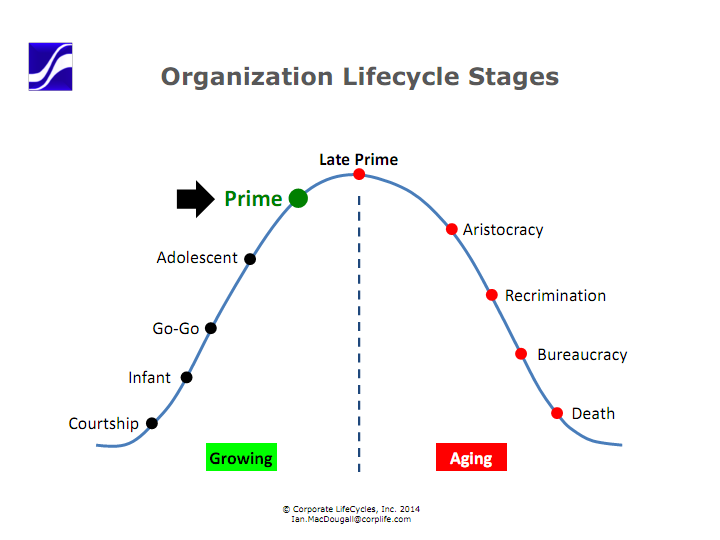Organization Lifecycles Management Seminar with Ian MacDougall on March 28, 2014
 Ian began his presentation by explaining the importance of knowing the road ahead and being familiar with every potential problem around each corner, emphasizing that if you are familiar with the potential problems ahead, you will be able to deal with them effectively.
Ian began his presentation by explaining the importance of knowing the road ahead and being familiar with every potential problem around each corner, emphasizing that if you are familiar with the potential problems ahead, you will be able to deal with them effectively.
His presentation was on the Organization Lifecycle Stages during the growing and aging phases.
There are five stages in organization growth:
Courtship: In this beginning phase there is no company, instead there is an idea and an entrepreneur. The entrepreneur sees an opportunity and is willing to take a risk. Often the entrepreneur is unrealistic. This is a very exciting time for a company. Focus is on getting loans and funds. Commitment is the most essential part of this phase.
Infant: The organization changes from dreaming to producing. Selling is the emphasis of this phase of the lifecycle. In this part of the lifecycle the companies are typically selling products at a loss in order to get cash. The focus is on survival. Organizational hierarchy is not an important consideration of the company. At this phase the customer is extremely important and the company will do anything to keep that customer. Entrepreneurs are putting everything into the company and are getting very little in return.
To move out of this phase companies need three items: consistent sales growth; repeat sales from customers; and positive cash flows from sales.

Typically a mistake will be made and this will result in a wakeup call for the founder which results in the transition of the lifecycle.
Adolescent: Issues here are with workload delegation, too much is on the founders shoulders. Organizational policies and procedures are typically required in this phase because of the significant growth in the company. The founder needs to hire a professional manager to deal with the organizational issues. There will be resistance to the professional managers policy will be from all of the employees and this will create friction within the company.
There is a risk here for business partnerships to fall apart in the adolescent phase. One partner will want more growth and more risk and the other partner is comfortable with the current progress of the company. The Board of Directors are most likely to fire a company founder throughout this phase since they are realizing the mistakes of the company and the entrepreneur can be fired.
Prime: Not the biggest, but widely considered the best. Sales grow; profits grow, and cash flows growing. Investors want to own stock; people want to work with you. It is difficult to stay in this phase because eventually prime companies start to feel the success.
Ian then took us through the five stages in organization aging:
Late Prime: The organization becomes complacent. As a result of finance controls, the organization wants to take fewer risks and to spend less money on marketing. The company rolls into the aristocracy lifecycle stage.
Aristocracy: Stage where too much emphasis is put on dress, décor, offices, etc. These companies have a lot of excess cash and often they will try to get back their youth by purchasing a “Go-Go” company.
Recrimination: Company is in trouble. There is a lot of finger pointing and trying to blame others for the company’s problems. The customer is not the focus in this phase and they are seen as a nuisance.
Bureaucracy: Companies quickly die in this phase, unless the government funds the company, but if the government stops their funding the company will die and become bankrupt.
He stated that none of the aging needs to occur because these factors can be diagnosed and maintained. Aging can be reversed. It has nothing to do with chronological factors and a company can be 100 years young or 5 years old. Organizational aging also has nothing to do with the relative size of a company.
MacDougall explained the differences in viewpoints between aging and growing companies. He stated that in a growing company, everything is permitted unless specifically forbidden. In an aging company, everything is forbidden unless specifically permitted. Growing company’s expectations exceeds results; in an aging company results exceed expectations. In growing phases, companies are flexible and unpredictable, in aging phases, companies are inflexible and predictable.
There are several factors of aging within organizations that can be diagnosed and reversed:
(1) Perceived Market Share: An organization needs to determine its market share as the numerator, and take the nearest competitor’s market share as the denominator. The more the quotient exceeds 1, the more the company is at risk of losing its entrepreneurial spirit and the closer they are to aging. A company needs to decide how they want to define the market and then consider this in their calculation. A company can have any market share they want. Ian reminded us that “There is no winning without the possibility of losing.”
(2) Mental Age of Key People: There is a high correlation between the mental age of key people and the entrepreneurial spirit. According to Ian, mental age is the disparity between what people have and what they want. People need to want something in order to maintain organizational growth. Ian reminded us, “There can be no change without dissatisfaction with the status quo.”
(3) Defining the company’s problems: Ian suggests that company’s ask employees what ‘we’ are not doing the best we can at. He reiterates the importance of using the term we: “Use ‘we’ not ‘you’. ‘You’ is accusatory. It is like saying your side of the boat is sinking. We are in the same boat.” Company’s should write down the 10 most wanted improvements in the company and work on dealing with these issues over time.
(4) Maintain organizational structure: it is important to split functions of the business between long-term thinking and short-term thinking in order to maintain organizational growth. Ian emphasized the importance of splitting sales and marketing, accounting and finance.
(5) Effective leadership: Ian provided an analysis of effective leadership throughout the lifecycle stages similar to a parent-child relationship. As parents, the role in the child’s life changes as it grows, as does the leadership role in an organization.







